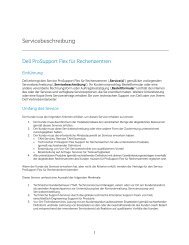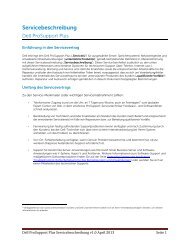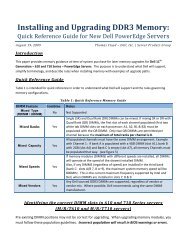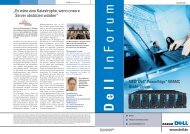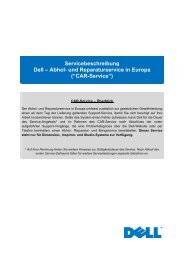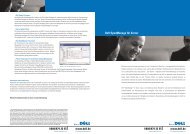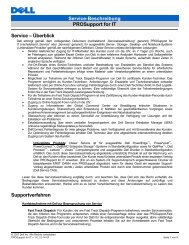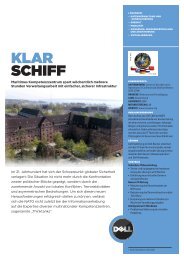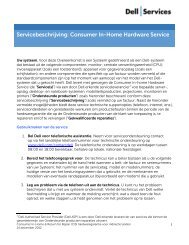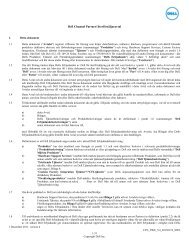Automate Configuration of HPC Cluster Nodes - Dell
Automate Configuration of HPC Cluster Nodes - Dell
Automate Configuration of HPC Cluster Nodes - Dell
You also want an ePaper? Increase the reach of your titles
YUMPU automatically turns print PDFs into web optimized ePapers that Google loves.
management s<strong>of</strong>tware and then pushed onto individual client nodes<br />
without configuring each node individually. This article describes<br />
how the DTK can be used in a Linux ® OS environment for typical<br />
configuration tasks performed on <strong>HPC</strong> clusters before the deployment<br />
<strong>of</strong> the cluster package as well as during maintenance tasks.<br />
It also discusses techniques for configuring BIOS, BMC, and DRAC<br />
settings and installing the <strong>Dell</strong> Utility Partition; these techniques can<br />
be scaled to include other DTK configuration features.<br />
Using the <strong>Dell</strong> OpenManage Deployment Toolkit<br />
in <strong>HPC</strong> clusters<br />
The life cycle <strong>of</strong> a typical <strong>HPC</strong> cluster can be divided into several<br />
phases, with different management tasks in each phase. The deployment<br />
phase involves remote power management, which is provided<br />
by the BMC and requires setting up parameters in the BMC options<br />
menu such as IP address, netmask, user ID, and password. The<br />
operational phase involves cluster health monitoring, which requires<br />
both in-band and out-<strong>of</strong>-band mechanisms be in place. To enable<br />
these mechanisms, BMC options such as username, password, and<br />
LAN alert destination and BIOS options such as boot sequence,<br />
snoop filter, Demand-Based Switching, logical processor, and console<br />
redirection settings must be configured.<br />
On ninth-generation servers, the DTK allows administrators to<br />
modify most configuration parameters <strong>of</strong> the remote system, specifically<br />
the BIOS, BMC, and DRAC 5 settings. Administrators can use the<br />
DTK syscfg tool to capture and replicate these settings. Alternatively,<br />
administrators can use an automated script to capture a complete list<br />
<strong>of</strong> BIOS and BMC settings and use this list as a comparison when<br />
troubleshooting problems such as failed nodes and performance<br />
declines. The DTK can help provide a safe preinstallation OS environment<br />
for performing necessary operations during the deployment <strong>of</strong><br />
an <strong>HPC</strong> cluster, helping reduce the time spent manually configuring<br />
each node in the cluster. Figure 1 outlines some DTK features and<br />
associated commands relevant to cluster deployment.<br />
Setting up the <strong>Dell</strong> OpenManage Deployment Toolkit<br />
environment<br />
The DTK is available in two versions: a Micros<strong>of</strong>t ® Windows ®<br />
Preinstallation Environment (WinPE) self-extractable zip file and<br />
a Red Hat ® Enterprise Linux 3 ISO image. Administrators can<br />
extract the WinPE tools and scripts obtained from the zip file and<br />
build them into a WinPE image. Administrators can also extract<br />
the tools and scripts from the Linux ISO image and use them<br />
in a customized ISO image, or use the image provided with the<br />
DTK. The information provided in this article refers to the Linux<br />
version <strong>of</strong> the DTK.<br />
Administrators can set up the DTK environment in a cluster<br />
using the PXE mechanism available on the master node. The PXE<br />
environment allows servers (in this case, the compute nodes) to<br />
HIGH-PERFORMANCE COMPUTING<br />
boot over a network connection. As each compute node boots into<br />
the lightweight Linux environment provided by the DTK through<br />
PXE from the master node, it executes the automated scripts that<br />
perform the required operations on the system.<br />
Installation prerequisites are as follows:<br />
• DTK 2.x CD (created by downloading the DTK ISO image<br />
from support.dell.com and burning the image on a CD)<br />
• Master node running Linux or a Linux-based OS<br />
• Compute nodes connected to the master node and ready<br />
to install<br />
Setting up the DTK environment on the master node<br />
A wide variety <strong>of</strong> cluster management s<strong>of</strong>tware is available, and<br />
administrators can use the DTK to configure basic BIOS, BMC,<br />
DRAC, and RAID settings on different types <strong>of</strong> <strong>Dell</strong> Linux clusters.<br />
Administrators must configure the Trivial FTP (TFTP) server on the<br />
master node; the directory used to serve files is typically the /tftpboot<br />
directory. The DTK kernel file (SA.1) and ramdisk file (SA.2), available<br />
with the DTK download, must be copied to the master node<br />
/tftpboot directory.<br />
After the DTK CD is mounted on the server, the files can be<br />
copied to the /tftpboot directory using the following commands:<br />
mount /dev/cdrom /mnt/cdrom<br />
cp /mnt/cdrom/isolinux/SA.1 /tftpboot/SA.1<br />
cp /mnt/cdrom/isolinux/SA.2 /tftpboot/SA.2<br />
umount /mnt/cdrom<br />
Administrators must also create a folder on the Network File<br />
System (NFS) share <strong>of</strong> the master node. In the example scripts<br />
shown in this article, /export/home/install/dtk carries the default<br />
sample scripts provided with the DTK as well as any custom scripts<br />
written for specific server configurations.<br />
Finally, administrators must place an entry for the DTK in the<br />
standard master node PXE configuration file for all the compute nodes<br />
to obtain the DTK kernel and ramdisk images over PXE. Figure 2<br />
shows an example PXE configuration file. The IP address <strong>of</strong> the<br />
master node (for the private network <strong>of</strong> the cluster) is set to 10.1.1.1.<br />
Additional examples for different types <strong>of</strong> shares are available in the<br />
isolinux.cfg file provided with the DTK Linux ISO image.<br />
Installing the <strong>Dell</strong> Utility Partition<br />
The <strong>Dell</strong> Utility Partition is a bootable partition on the hard drive<br />
that contains diagnostic and system utilities. The partition is typically<br />
between 32 MB and 60 MB. Installing the partition requires<br />
the latest <strong>Dell</strong> Utility Partition images, which are provided by <strong>Dell</strong><br />
OpenManage Server Assistant (available on the <strong>Dell</strong> Installation and<br />
Server Management CD that ships with PowerEdge servers).<br />
www.dell.com/powersolutions Reprinted from <strong>Dell</strong> Power Solutions, February 2007. Copyright © 2007 <strong>Dell</strong> Inc. All rights reserved. DELL POWER SOLUTIONS 97



